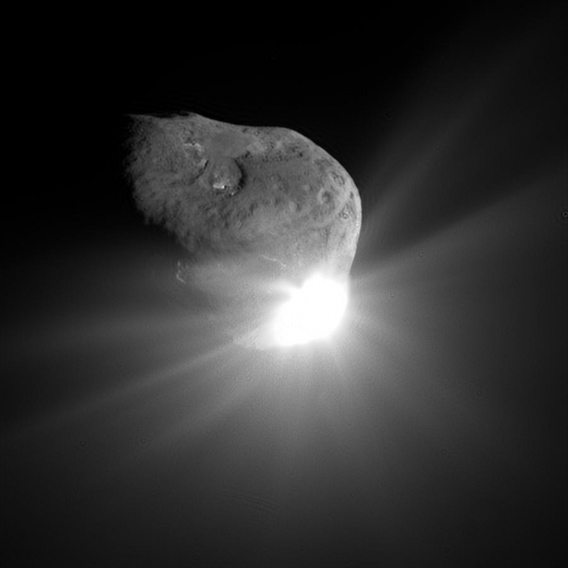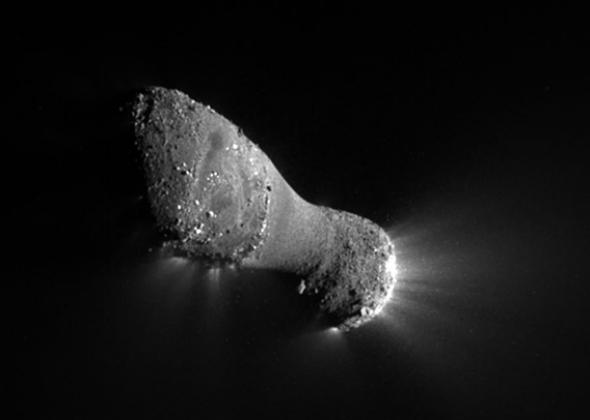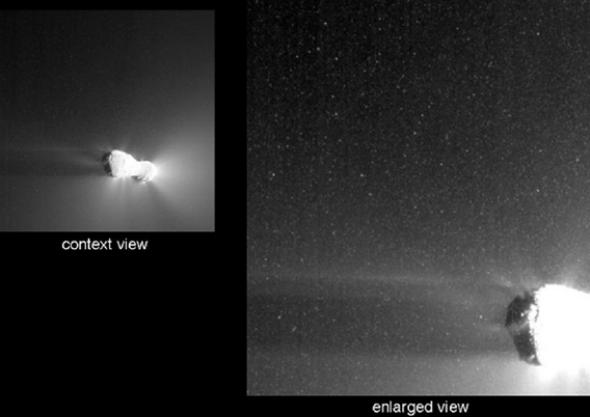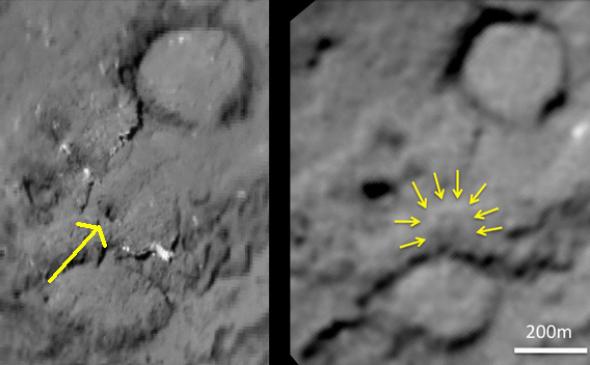Epic Comet Mission Fades to Black

Photo by NASA/JPL-Caltech/UMD
After more than eight years in space, 7.6 billion kilometers traveled, and a close-up view of not one but two comets—one of which was really, really close-up—NASA’s Deep Impact mission has gone dark. The last signal from it was received on Aug. 8, 2013, and the mission has been declared officially over.
It appears that a computer timing error doomed the spacecraft, creating a loss of attitude—that is, making it impossible for the probe to maintain the correct orientation to communicate with Earth, and tipping the solar panels away from the Sun, so it could no longer power itself.
This loss of the mission is sad, but it comes after a tremendous list of accomplishments.
Rendezvous with a Comet
The comet probe was launched in January 2005 with an epic adventure ahead of it: a rendezvous with the comet Tempel 1. Two days before the flyby, a smaller probe was released—an impactor. Containing a 370 kilogram (815 pound) block of copper as a dead weight, the impactor was equipped with thrusters, cameras, and a debris shield to insure its final goal: to collide with the solid comet nucleus at more than 10 km/sec (22,000 miles per hour)!
On July 4, 2005, the impactor slammed into the comet, carving out a crater 150 meters across in the 7.6 x 4.9 km (4.7 x 3.0 mile) wide comet. The video of it is stunning:
That is comprised of images taken from the main probe that flew by the comet after it released the impactor. The flash of light was so bright that even from Earth, at a distance of 133 million km (83 million miles), it was easily visible through a telescope. Inset here is a picture colleagues of mine at Sonoma State University and I took using a 36 cm telescope; it’s a composite of 50+ images. The comet’s motion brought it from the lower right to the upper left, and you can see how it got substantially brighter after the impact.
The mission goal was to excavate material and see what things looked like under the surface of the comet. However, there was too much debris for Deep Impact to get a good look at the time. Years later, NASA directed the Stardust space mission to fly by Tempel 1, where it passed close enough to view the excavated crater, seen above.
It was found that the impact blasted out some five million kilograms (5000 tons) of water and twice that much dust and rock. An animated GIF was created showing the view from the impactor itself as it approached Tempel 1 in its Final Plunge. I love the frantic, frenzied feel of it.
Sticking with EPOXI
The impactor’s mission was over—really over—but the spacecraft itself sailed on. Not one to waste a good mission, scientists and engineers at NASA and the University of Maryland (the home office of the mission) dreamed up new tasks for the probe. The mission was extended, and renamed EPOXI: a combination of Deep Impact Extended Investigation (DIXI), and EPOCh (Extrasolar Planet Observation and Characterization). It was tasked with flying by another comet, and looking for planets orbiting other stars.
The second comet in this case was Hartley 2, a small (2 x 0.5 km) chunk of ice and rock. To get there for its 2010 rendezvous, EPOXI had to fly by the Earth and use our gravity to change its orbit. From 50 million km away, the spacecraft took a series of images showing the rotating Earth and a cosmic photobombing by the Moon that has to be seen to be believed:
That video is in visible light plus infrared; land and vegetation reflects IR well, so those areas stand out. My old boss Don Lindler put that video together, and it still amazes me.
And EPOXI flew on. On Nov. 4, 2010, it passed an astonishing 700 km (430 miles) from the surface of Hartley 2, returning jaw-dropping close-up photos of the comet.

Photo by NASA/JPL-Caltech/UMD
You can see the comet is shaped like a bowling pin, studded with boulders in its surface (here’s a very cool 3D anaglyph view if you have red/green glasses). The bright fans of light are jets; streams of water and carbon dioxide blasting off the comet. Deposits of ice on or near the surface warm up as the comet approaches the Sun, turning directly from a solid to a gas. As they expand, these jets from the fuzzy head and long, streaming tail from the comet.
So much material streams of the comet, in fact, that the solid part of the comet can cast a visible shadow on the jetsam:

Photo by NASA/JPL-Caltech/UMD/Brown
But the mission accomplished still more. As it cruised around the solar system, it observed several stars known to have massive exoplanets orbiting them. By sitting and staring at those stars, it could observe the short dimming of starlight caused by the planets physically getting between their stars and us, a process called a transit. By measuring how much light is blocked, the size of the planet can be inferred. I have to note: I wrote an article about EPOXI being used to observe transiting planets back in February of 2008…where I carefully note that a whopping 33 transiting exoplanets were known. Now, just five years later, we know of hundreds that have been confirmed, and have a list of several thousand more candidate exoplanets.
I have to add that in 2010, while observing Earth during a flyby, EPOXI also caught a series of glints, reflections of sunlight off of water. The video of that is lovely, and in fact very useful: in 2009 Cassini used a similar method to confirm the existence of liquid lakes of methane on Saturn’s moon Titan!
Sailing On
The Deep Impact mission had a personal connection with me—beyond that of observing the moment of impact myself. At the time, the BBC put together a documentary about the mission that was a mix of taped interviews and live events as the impact occurred. I was invited to go to LA to be interviewed by an up-and-coming young science promoter from England for the show, and I thought it would be fun. It was, very much, and it was at that taping that I met the interviewer, Brian Cox, now a superstar in science outreach. We’ve been friends ever since.
Losing a mission—whether it’s from malfunction, loss of funding, or just old age—is never good. But I think it helps in this case to know that Deep Impact/EPOXI did far, far more than it was originally designed to do. From a splashy mission to dig up What Lies Beneath a comet, to observing the Earth, the Moon, another comet, and even exotic planets orbiting alien stars, Deep Impact may be counted among the most successful space missions of all time, going well beyond its initial mission profile.
It reflects something in us, I think, to show that sometimes we don’t accept the end as The End. Just because the basic chores were done doesn’t mean there isn’t a grand Universe out there to keep exploring. All we have to do is first imagine doing it, and then imagine how to do it.
There is an old expression: Our reach should exceed our grasp. But I think that severely underestimates just how much we can actually grasp.
My thanks to the scores of men and women who conceived of, designed, built, and flew Deep Impact, and then kept it going so that its reach could keep up with its grasp. Congratulations on a job extraordinarily well done.
![deepimpact_spacecraft NASA's Deep Impact spacecraft [artist's impression]](/content/dam/slate/blogs/bad_astronomy/2013/09/21/deepimpact_spacecraft.jpg.CROP.promovar-mediumlarge.jpg)
Artwork by NASA & ESA



